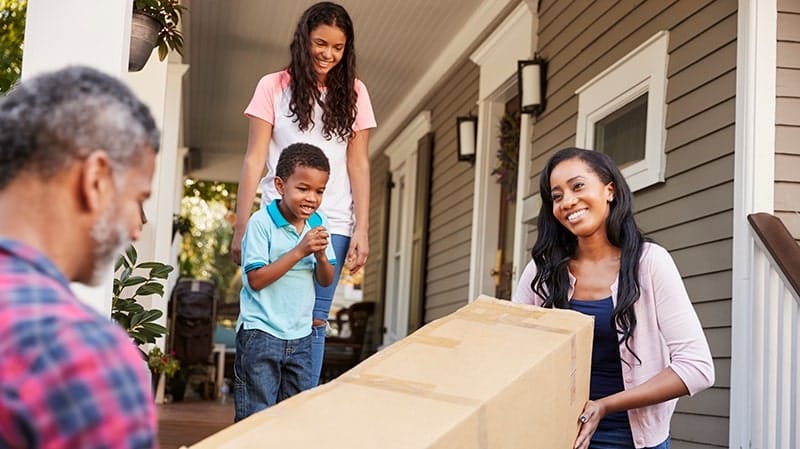Moving is a big milestone: exciting, but also one of life’s most stressful events. Safety often takes a back seat to the chaos of boxes and checklists, yet it’s one of the most important parts of the process. These moving safety tips will help you protect yourself, your family, and your belongings before, during, and after the move. From safe packing strategies to home security steps once you’re settled in, here’s how to make your move smooth and secure.

Safety Before and During the Move: Packing, Planning, and Decluttering
1. Create a Moving Inventory for Safer Packing
Start by creating a written inventory of your items. It may seem tedious, but grouping belongings before you pack prevents lost or misplaced boxes and makes unloading easier. A clear checklist also reduces the chance of injury by helping you pack smarter, not harder.
2. Decluttering for a Safer, Smoother Move
Moving is the perfect time to downsize. Purging unused clothes, furniture, and other items lightens your load and reduces tripping hazards while living among moving boxes. Less clutter also means fewer heavy items to carry, lowering the risk of back strain and other injuries.
3. Packing Safety: Plan Ahead and Separate Essentials
Start packing well in advance, beginning with off-season or holiday items. As you move closer to moving day, keep valuables and daily essentials separate and clearly labeled. This makes them easy to grab in a hurry and prevents heavy boxes from being overfilled at the last minute.
4. Group Items by Room and Label Clearly
Pack belongings from each room together to make unloading smoother and safer. Clearly label boxes with their destination room so movers don’t have to guess where heavy boxes belong. This avoids extra lifting and keeps fragile items where they belong.
5. Avoid Overpacking to Prevent Injuries
Pack heavy items like books or cookware in smaller boxes for easier lifting. Use larger boxes for lighter belongings such as clothes or bedding. Following this rule helps prevent injuries and makes moving day less physically demanding.
6. Moving Day Safety for Kids and Pets
Pets and children are especially sensitive to the chaos of moving. Stick to your pet’s usual routine as much as possible to reduce stress. Gradually expose them to moving supplies and noises (like tape or boxes) so they’re less startled on moving day. If possible, take your dog for a walk around the new neighborhood before the move so they’re familiar with the environment. Keep kids and pets occupied with activities or supervised care while boxes are being carried to prevent accidents.
7. Choosing a Safe, Reliable Moving Company
Whether you enlist friends and family or hire professionals, book early to avoid last-minute stress. If you’re hiring movers, do your research carefully. Sadly, moving scams are common, and dishonest companies may overcharge, demand large deposits, or even hold belongings hostage. Learn how to avoid moving company scams by recognizing red flags before you sign a contract.
8. Tie Up Loose Ends Before Moving Day
Don’t let small details become big headaches. Transfer or schedule utilities, update your mailing address, and confirm bills are redirected. Just as importantly, make sure your home security system is ready for the move. Having your security system professionally set up at your new home gives you peace of mind from day one.
Time to get settled in: tips for your new home.
1. Change Locks and Secure Entry Points
We highly recommend changing the locks on your doors. You never know how many copies of that key are floating around. Consider a smart door lock or video doorbell for extra security.
2. Neighborhood Safety: Get to Know Your Surroundings
Take time to learn about your new neighborhood using reliable online resources such as CrimeMapping, NeighborhoodScout, CityProtect, and AreaVibes. These sites provide up-to-date information about local crime statistics and community safety trends. Introducing yourself to neighbors can also provide an added layer of security and foster community support. For those interested in taking a more active role, learn how to join a Neighborhood Watch program by reading our detailed guide on the Top Neighborhood Watch Apps to download.
3. Emergency Preparedness After a Move
Know who to call in an emergency before you need them. Identify the nearest emergency services, and plan family escape routes for fire or other hazards. Practicing these routes with children ensures everyone knows what to do if an emergency happens at night or when routines are disrupted
4. Set some boundaries.
Establish clear safety rules for children and guests. This might include locking doors, avoiding dangerous areas like garages or attics, and not sharing alarm codes. For additional ideas, explore Guardian’s Kids’ Safety Guide for practical advice on keeping children safe at home.
5. Be proactive.
Burglars often look for easy targets, but you can deter them with a few simple steps. Keep a car parked in the driveway, close blinds at night, and be mindful of leaving valuables in view. Understanding common burglary prevention tactics helps you stay ahead of threats and keep your home secure.
6. Professional Home Security Options
Installing a home security system is one of the most effective ways to protect your new home. Studies show that 60% of burglars will avoid a property if they see signs of a security system.
Guardian’s monitored systems go beyond burglary prevention by detecting fire, carbon monoxide, and unexpected openings of doors or cabinets. From security cameras to motion detectors, you can customize your setup to fit your family’s needs. Ready to get started? Call Guardian at 1.800.PROTECT (1.800.776.8328) for a free quote.
Frequently Asked Questions
The most important moving safety tips include creating a packing plan, lifting boxes properly, decluttering to reduce hazards, and keeping kids and pets safe during the process. After you move, secure your locks, get to know your neighborhood, and set up a home security system for added protection.
Avoid injuries by packing heavy items in smaller boxes, using proper lifting techniques, and wearing supportive shoes. Ask for help when moving large items and don’t overload boxes. It’s safer to make multiple trips than to risk straining your back.
Keep children and pets away from high-traffic areas on moving day. Stick to their regular routines when possible, provide distractions like toys or activities, and arrange supervised care so movers can work without risk of accidents.
After moving, change your locks, check smoke and carbon monoxide detectors, and familiarize yourself with local emergency services. For long-term protection, consider installing a professionally monitored home security system with cameras, sensors, and smart locks.
Yes. Moving scams can leave families without their belongings or force them to pay inflated costs under pressure. To stay safe, always verify a mover’s license and reputation. Learn how to avoid moving company scams before hiring.
After moving, secure all doors and windows, set up door and window sensors, and test your smoke and carbon monoxide detectors. For complete protection, consider a monitored home security system that includes cameras, motion sensors, and smart locks.

